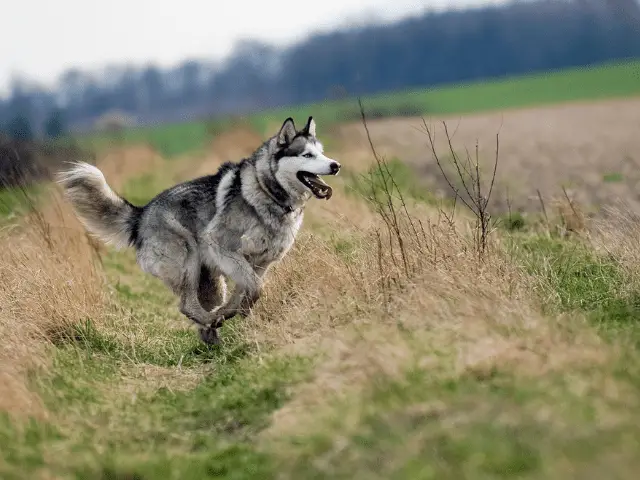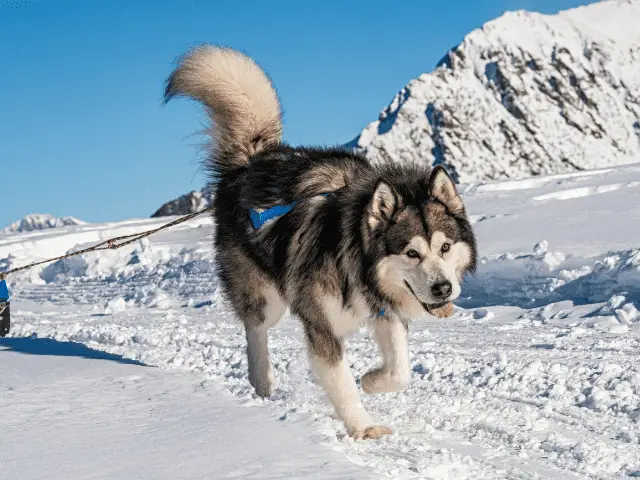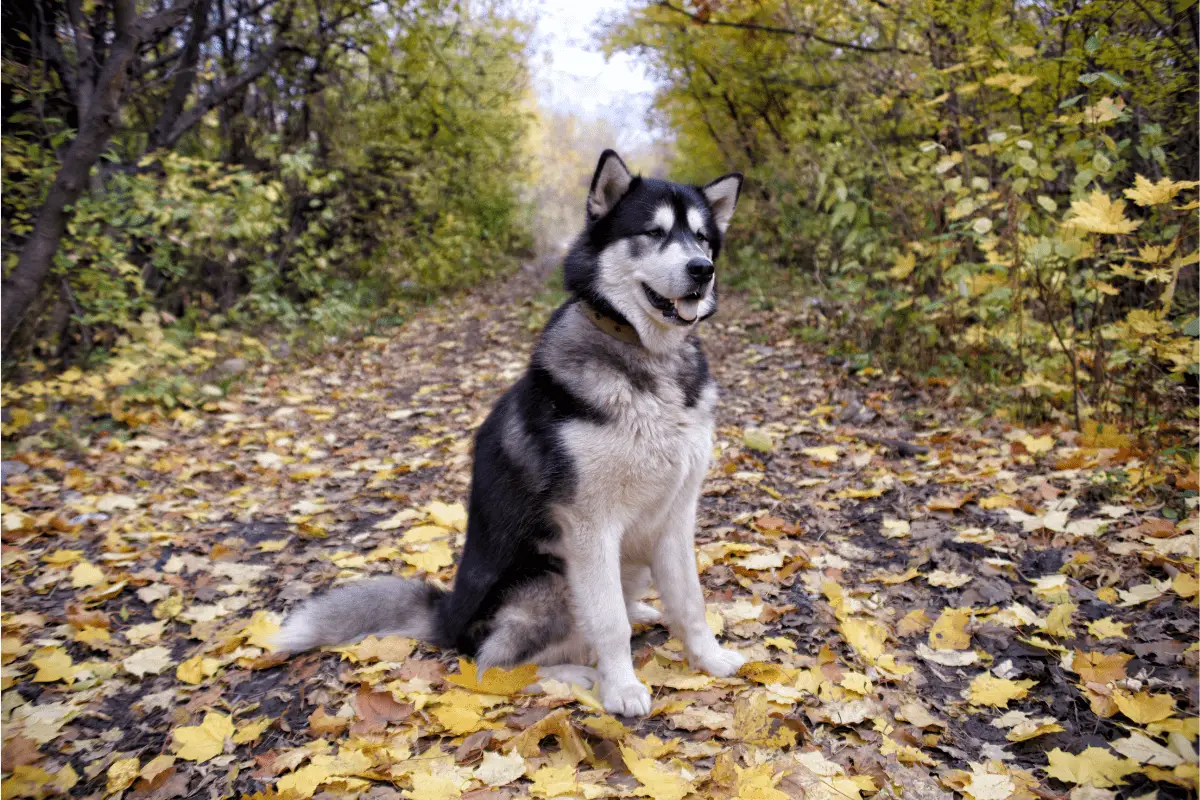Spending time outdoors has been proven to improve mental health and overall wellbeing and adding a canine companion to your travels is a great way to make hiking even more fun.
Just like people, dogs enjoy a variety of different activities and for hikers considering bringing a canine companion along for the adventure, it’s important to understand the breed and the best conditions for each individual dog.
Alaskan Malamutes, often simply referred to as Malamutes, can make the ideal hiking companion for avid hikers due to their determined personality, unyielding loyalty, and friendly and outgoing demeanor. Understanding the breed, their health considerations, and what types of activities they excel at will create an ideal lifelong hiking buddy.
This page contains affiliate links. If you use these links to buy something I may earn a commission. Thanks.
Health Considerations in Alaskan Malamutes
When considering bringing a pet along on a hike, owners should be aware of any potential health risks associated with their dog’s specific breed as some breeds may be predisposed to health conditions that may impair their hiking abilities.
Although Alaskan Malamutes are generally healthy dogs with an average lifespan of 10-14 years, pet owners considering bringing a Malamute home should be aware that this breed is prone to a genetic condition of the bones and joints known as elbow or hip dysplasia .
.
This condition causes irregular growth of the ball and socket joint, causing the femur and the adjoining socket of the pelvis to grow at disproportionate rates that result in joint laxity. If left untreated, this condition can lead to degenerative joint disease or osteoarthritis which can severely diminish a dog’s hiking ability.
which can severely diminish a dog’s hiking ability.
Dogs diagnosed with hip dysplasia may have limited hiking abilities, but owners can prolong their pet’s quality of life by providing supportive care in the form of feeding a balanced diet for each stage of life, adding joint support supplements, or taking advantage of veterinary rehabilitation services.
Slow, controlled hikes on level terrain may actually be beneficial to dogs diagnosed with hip dysplasia as movement helps reduce stiffness and swelling of the joints.
Alaskan Malamute owners should schedule their dog for a thorough veterinary exam before hiking to ensure they are physically fit for the activity and always be mindful to monitor their pets along the trail. Affected dogs may display symptoms of pain such as limping, lethargy, or being slow or unable to rise after periods of activity.
Alaskan Malamutes are a Highly Active Breed

Alaskan Malamutes are large, powerful working dogs that have a natural affinity for physical activities like hiking. Originally used as sled dogs to carry people and supplies across the snowy terrain, Malamutes have high endurance and can easily enjoy hikes of 5-10 miles or more with proper training and conditioning.
Owners attempting long-distance or multi-day hikes with their Alaskan Malamute should consult their veterinarian before beginning hiking to ensure their pet is healthy enough for long treks. Owners should also pack enough supplies for the hike including:
- Plenty of fresh drinking water
- Snacks and meals
- Collapsible bowls
- Leash and collar with identification tags
- Pet first aid kit
- Canine hiking gear such as booties for rough or snowy terrain
Consider a Canine Hiking Pack
Hikers looking to lighten their own load may want to consider trying out a canine hiking pack for their Malamute to carry some of their own gear. Although it may take some getting used to, Alaskan Malamutes can easily learn to carry their own hiking supplies without overexerting themselves due to their naturally high work ethic and strong, muscular physique.
for their Malamute to carry some of their own gear. Although it may take some getting used to, Alaskan Malamutes can easily learn to carry their own hiking supplies without overexerting themselves due to their naturally high work ethic and strong, muscular physique.
Canine hiking packs should be appropriately fitted following manufacturers’ guidelines and should never be used to carry more weight than recommended as this may cause back pain or other physical injuries to Alaskan Malamutes.
Mental Stimulation Needs for Alaskan Malamutes
In addition to receiving adequate physical exercise, Malamutes are a highly intelligent breed that requires daily mental stimulation to keep them happy and healthy. Known for their headstrong personalities, Malamutes are pack animals that do best with an experienced owner who is able to set ground rules and provide proper training at an early age.
Malamute owners should be prepared to provide a minimum of 1-2 hours of mentally stimulating activities to their dog each day which can easily be incorporated into a hike. Creating a mentally stimulating hiking environment is as easy as trying out a new trail or route that introduces the dog to new sights, sounds, and smells that keep their brains focused and functioning.
For hikers looking to incorporate even more mentally stimulating activities into their hike, working on tasks that require concentration like obedience and recall training can be a great way to keep dogs mentally active.
Off-Leash Hiking with Malamutes
While Malamutes can make great off-leash hiking companions, owners should be aware that this will likely require a great deal of training as this headstrong breed often displays dominant tendencies that require a watchful eye.
Conversely, Malamutes have an outgoing personality and friendly demeanor that help them easily make friends along the trail with other dogs as well as hikers. Each trail has different guidelines when it comes to off-leash hiking with dogs and owners should ensure they have researched the rules and requirements prior to their hike.
Alaskan Malamutes Were Born for Cold Weather

As their name suggests, Alaskan Malamutes originally hail from the US state of Alaska that’s known for its arctic weather and harsh winters, making them hearty dogs that love cold weather.
As one of the many dog breeds possessing a dense double coat , Malamutes are able to withstand freezing temperatures easily and are often found rolling and frolicking around in the snow. Winter hiking offers these dogs their ideal weather condition and owners have often reported these adventurous dogs as enjoying spending hours outside when the weather is “nice.”
, Malamutes are able to withstand freezing temperatures easily and are often found rolling and frolicking around in the snow. Winter hiking offers these dogs their ideal weather condition and owners have often reported these adventurous dogs as enjoying spending hours outside when the weather is “nice.”
On the other hand, Alaskan Malamutes are not great candidates for warm-weather activities due to their dense hair coats.
Although many owners think that shaving a double-coated dog will help their pets stay cool in the summer, this can actually disrupt the function of the haircoat. Double-coated dogs should never be shaved as this can actually make it more difficult for dogs to regulate their body temperature and therefore it should be avoided in Malamutes.
Owners are encouraged to follow proper grooming techniques to preserve the function of the coat by routinely brushing their dog to keep the coat free of moisture, debris, and mats.
to preserve the function of the coat by routinely brushing their dog to keep the coat free of moisture, debris, and mats.
Camping with Alaskan Malamutes
For owners taking part in multi-day hikes or camping excursions, Malamutes can make the ideal camping partner. In addition to providing companionship for their owners, Malamutes are very adaptable to new surroundings and make friends with almost anyone they meet.
Owners wanting to incorporate camping into their hikes should ensure their Alaskan Malamute is never left unattended, especially during nightfall as dangerous wildlife may pose a threat to unattended pets.
Anyone considering camping with a dog should ensure they follow proper socialization techniques from a young age to provide the best camping experience for both dogs and their owners.
from a young age to provide the best camping experience for both dogs and their owners.
High Elevation Hiking with Malamutes

Alaskan Malamutes are one of the best dog breeds around when it comes to high elevation hiking, but they will require proper training as dogs can be prone to altitude sickness and serious health complications can occur if they are not properly conditioned to high elevation hiking.
When first introducing a dog to high elevation hiking, owners should always keep their dog on a leash to control speed and increase altitude very gradually to avoid complications. High elevation hiking can quickly cause dehydration in hikers and Malamutes should be encouraged to take plenty of water breaks.
A good rule of thumb is that every time a hiker takes a drink of water, they should also offer water to their dog.
Elevation hikers should ensure they understand the risks of high-altitude hiking for themselves and their pets and receive clearance from a veterinarian before hitting the trail. Symptoms of altitude sickness in pets include labored breathing, nausea/vomiting, excessive panting, pale gums, increased heart rate, and collapse.
Alaskan Malamutes can make the ideal trail companion for avid hikers that have time to dedicate to training and enrichment for their canine companion. This friendly, loyal, and active breed possesses unyielding endurance and stamina that help them excel at hiking and keeping their owners safe and happy while building memories on the trail that will last a lifetime.
More Links and Info
We’ve partnered with breed owners and vet techs to bring you comprehensive Breed Specific Hiking Guides, including a wide range of breeds from Rottweilers all the way to Yorkies.

